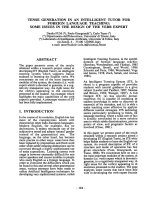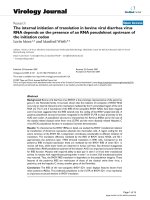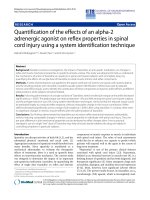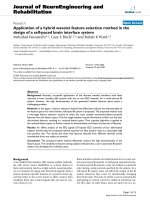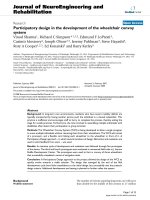Biomechanical considerations in the design of an artificial hand
Bạn đang xem bản rút gọn của tài liệu. Xem và tải ngay bản đầy đủ của tài liệu tại đây (694.87 KB, 13 trang )
International Journal of Mechanical Engineering and Technology (IJMET)
Volume 10, Issue 12, December 2019, pp. 330-342, Article ID: IJMET_10_12_036
Available online at />ISSN Print: 0976-6340 and ISSN Online: 0976-6359
© IAEME Publication
BIOMECHANICAL CONSIDERATIONS IN THE
DESIGN OF AN ARTIFICIAL HAND
Oscar F. Avilés., Daniel H. Sánchez, Oswaldo Rivera,
Mauricio Mauledoux, Oscar I. Caldas
Universidad Militar Nueva Granada, Programa de Ingeniería Mecatrónica, Grupo de
Investigación en Mecatrónica DAVINCI, Cr 11 No. 101-80 Bogotá D.C, Colombia
ABSTRACT
This paper presents the design of a hand prosthesis and the implementation of an
anthropomorphic finger with three degrees of freedom. The design integrates
anatomical considerations, which will be emulated with alternative materials that
meet the biological characteristics of the hand. The built model is inspired by the real
anatomy of a human finger, in order to provide all the different handholds. The
calculations of the direct and inverse kinematics are made in order to know the
workspace and points of the final effector of the anthropomorphic finger.
Keywords: Prosthesis, Anthropomorphic Finger, Anatomy, Tendons, Cartilage,
Kinematics, Grip Taxonomy.
Cite this Article: Oscar F. Avilés., Daniel H. Sánchez, Oswaldo Rivera, Mauricio
Mauledoux, Oscar I. Caldas, Biomechanical Considerations in the Design of an
Artificial Hand. International Journal of Mechanical Engineering and Technology
10(12), 2019, pp. 330-342.
/>
1. INTRODUCTION
The success of mankind evolution is mostly due to its ability to explore and study the
surrounding world, but also to the workability of the human being. With the hand objects
grabbing, holding and manipulating can be performed with great skill, which is important for
performing tasks of daily living with tools.
Robotic hands are clearly human-inspired, and their models have led to innovative and
expensive fingers prototypes to be used as functional parts of anthropomorphic robots.
Several work can be found in literature, such as in Stanford / JPL Hand [1], UTAH / MIT
Hand, TUAT/Karlsruhe Humanoid Hand, DLR Hand, NASA Robonaut or UMNG Hand.
Other related works are the fingers of m. Cecarelli et al [8], who proposed the motion
kinematics of human fingers, using sequences of video recording and photo as a methodology
to determine the function of the movement. Garcia et al [9] used a system which emulates the
performance of the finger muscular system, represented by a transmission system based on
tendons. Fabrizio Lotti et al [10] developed a finger that has two degrees of freedom and low
weight, using rigid links connected with flexible elements and actuators for linear
displacement. In Table 1, a review of some related works on robotic hands is presented [14].
/>
330
Biomechanical Considerations in the Design of an Artificial Hand
Table 1: Technical characteristics of various artificial hands
Size
(norm.)
# of
fingers
DOF
1
5
22
(Otto Bock, 2002)
≈1
3
1
(Kyberd,1995)
(Light, 2000)
(Fujii, 1998)
(Fukuya, 2000)
(Li-Ren, 1996)
(Jacobsen, 1983)
(Bekey, 1988)
(Salisbury, 1983)
(Butterfas, 2000)
> 1.1
>1
>1
≈1
≈1
>2
≈1.1
≈ 1.2
≈ 1.5
3
5
5
5
5
4
4
3
4
Robonaut
(Lovchik, 1999)
≈ 1.5
5
Gifu
(Kawasaki, 2001)
5
2
6
7
17
17
16
4
9
13
12 +
2
16
(Bonivento,
1992)
3
Human Hand
Ottobock
SUVA
MARCUS
Southampton
Hokkaido
Karlsruhe
NTU
Utah/MIT
Belgrade/USC
Stanford/JPL
DLR II
UB
Okada
(Kandel,2000)
(Okada, 1979)
Actuators
(type)
38
(Muscl)
Control
# of
Sensors
Weight
(g)
Force
(N)
Speed
(s)
E
≈17’000
≈ 400
> 300
0.25
1 (E)
I
2
600
< 100
<1
2 (E)
6 (E)
7 (E)
17 (E)
17 (E)
32 (P)
4 (E)
12 (E)
13 (E)
I
E
E
E
E
E
E
E
E
400
125
201
1570
11001
320
38
12
31.8
-45
30
2.51
0.1
-
14 (E)
E
-
-
-
I
E
3
35
16
23+4
64
43 +
touch
-
-
-
-
13
E
E
-
-
-
-
3
11
E
E
-
-
-
-
Barret
(Townsend,
1988)
3
4
I
E
-
-
-
-
DLR I
(Butterfas, 1997)
4
12
I
E
-
-
-
-
LMS
(Gazeau, 1998)
4
16
E
E
-
-
-
-
Dist
(Cafés, 1998)
5
16
E
E
-
-
-
-
5
5
5
P
P
P
E
E
-
-
-
-
≈1
4
13
23
12
12 +
2
12(E)
E
4 force
-
-
-
Ultralight
Shadow
Tokyo
(Schultz, 2000)
(Shadow Co, 2002)
(Lee, 1999)
UMNG
(Ocampo, 2004)
Currently, advanced robotics is moving from the classical concept of precise and rigid
structures, often heavy and complex, to more flexible and lightweight structures, with the
prospect of an increase in performance, high mechanical simplicity and therefore a
considerable cost reduction. The robots, especially humanoid and industrial manipulators, are
designed to assist in various jobs in industry and at home. Therefore, these robots need to be
able to perform tasks that humans normally do, and they must be provided with an end
effector (tool) that can manipulate objects with the same skill of a human being, as shown in
Fig. 1
The design of an anthropomorphic hand is highly complex and depends on the tasks
desired to be performed. The main objective is the realization of common tasks in daily life,
including the different types of grip as shown in Fig. 1.
/>
331
Oscar F. Avilés., Daniel H. Sánchez, Oswaldo Rivera, Mauricio Mauledoux, Oscar I. Caldas
Figure 1. Schematic of a human hand
2. ANATOMY OF THE HAND
The different components of the prehensile system are inspired in the human hand. The
objective is to mimic the hand skills and interaction with different environments [8].
The human hand is connected to the wrist and has twenty-two DOF moved by closely
forty muscles [9, 10]. From fig. 1, the thumb is fixed more proximal than the other fingers and
thanks to its carpal and metacarpal bones [9, 14] it can close and rotate, so the orientation
plane can be changed allowing the thumb to oppose the other fingers, allowing the
extension/abduction movement (in and out from the hand).
2.1. Geometric Model
The knowledge of the geometric model of the human hand is one of the purposes in this work,
in order to properly design a finger and an artificial hand. Besides of the possible simulations,
the geometric model allows to evaluate the proposed theoretical hypotheses and facilitates the
understanding of position and orientation of the fingers with respect to a reference point.
2.2. Skeletal Description of the Hand
The five fingers of the human hand can be referenced like this: thumb
; index
; middle
; ring
; and pinky
. The last four fingers are
formed by four bones referenced as follows: Metacarpal phalange (Pi0), proximal phalanx
, middle phalanx
and distal phalanx
. The thumb is the shortest of all (it has
two phalanges), and it is composed of five bony pieces: scaphoid bone
, trapezius
, first metacarpal
, first phalanx
and second phalanx
. Table 3 shows
the dimensions of the aforementioned bones.
2.3. Two-Finger Interphalangeal Biomechanics
All the joints are formed by reciprocal interconnections in each of the phalanges. The
adjustment in these joints is maintained and stabilized by the lateral ligaments. Depending on
the bony surfaces in contact and the arrangement of the ligaments in the joints, fingers can
have 1, 2 or 3 degrees of freedom. Excluding the thumb fingers have two types of joints:
metacarpo-phalangeal (Oi1) and proximal and distal inter-phalangeal (Oi2), (Oi3), the thumb
has three: the trapezo-metacarpal (O01), metacarpophalangeal (O02), interphalangeal (O03),
(see Fig. 2).
The human hand has 25 active DOF divided into 5 DOF per finger, those DOF differ
between the thumb and the other fingers. For a correct and agile manipulation, one must
/>
332
Biomechanical Considerations in the Design of an Artificial Hand
analyze how an object is grasped and manipulated and what forces must be applied to it. The
development of a robotic hand requires knowledge of the geometric relations of the
manipulator-object system, therefore, there are two main kinematic models in a multi-finger
manipulation system: hand kinematics and contact kinematics. In Fig. 2, a model of the hand
can be seen as a kinematic chain according to the mobility of each of the joints.
Figure 2: Biomechanical equivalence in an artificial hand
The muscles and joints of the hand allow great deal of prehensile configurations which
can be divided in two main groups, the prehensile and non-prehensile. In the first group, the
object can be grabbed partially or fully within the hand, meanwhile the second one does not
involve grabbing actions, instead the objects are lifted with the entire hand or just the fingers
(see Fig. 3).
Figure 3: Taxonomy of human prehensile models
For the design of an anthropomorphic finger, the following measurements are considered
according to the approximation of the lengths stipulated in Table 2 and Table 3.
/>
333
Oscar F. Avilés., Daniel H. Sánchez, Oswaldo Rivera, Mauricio Mauledoux, Oscar I. Caldas
Table 2 Average anthropomorphic data for index finger
Phalanx
Phalanx
measurements
[mm]
19,67±1,03
Distance between
phalanx [mm]
5,58 ± 0,92
24,67 ± 1,37
7,57 ± 0,45
43,57 ± 0,98
15,57 ± 0,84
71,57 ± 5,60
Table 3. Human hand articulations and boundaries
Element
Joint
DOF
Fingers
“
“
Thumb
“
“
DIP
PIP
MCP
IP
MCP
CMC
1
1
2
1
2
2
Flex-Ext
angle
60
100
90
85
50
120
Abd-Add
angle
----60
--30
45
2.4. Kinematics
For the formulation of the kinematic model of the human hand the Denhavit & Hartenberg DH formalism is used. With this method modeling is done through local vectors, where the
positions and orientations of various points of interest are obtained and used for the graphic
construction of the model, through primitive elements.
From the definition of the joints of the skeletal structure, define a reference system for
each point Oi. Fig. 4 shows the structure of a human finger and its corresponding coordinate
systems, as well as the joint variables that are considered to obtain the model.
2.5. Direct Kinematics
With the acquired data from the finger, a prototype for the hand is designed (Fig. 6) keeping
in mind the following requirements in the designing process:
Absence of all DOF in the wrist (it is designed to be part of a robotic arm). The only movable
pieces will be the fingers.
The metacarpal phalanx articulation only has one DOF.
The distal inter phalanx and proximal inter phalanx articulations are revolution joints (1DOF).
By
using
the
Denavit-hartenberg parameters (table in Fig. 4) where
are the angles for each phalanx, p is the length of the palm, and
are the distances of each phalanx.
/>
334
Biomechanical Considerations in the Design of an Artificial Hand
Joint
1
2
3
4
5
6
7
1
2
3
4m
5m
6m
7m
l1
0
0
p
0
f1m
f2m
f3m
d1
0
0
0
0
0
0
0
i
90
90
0
-90
0
0
0
Figure 4: Geometric representation of a finger 3 DOF
(1)
Where
is the angle between phalanges, (
is a homogenous transformation
matrix, is the length of each phalanx and
is the position of the fingertip.
Having the matrices of transformation of each joint, the next step is to multiply them all to
obtain the general matrix that indicates the final position in which the anthropomorphic finger
is. The last generated matrix is different from the others because it is constant while the
previous matrices depend on the joints.
Taking into account that
y
the transformation matrix is:
(2)
[
]
Where:
/>
335
Oscar F. Avilés., Daniel H. Sánchez, Oswaldo Rivera, Mauricio Mauledoux, Oscar I. Caldas
These equations give the value of the position of the fingers of the hand
as a
function of the joint coordinates. With the data obtained from the solution of the problem of
direct kinematics, the points that the fingertip can reach by performing the movements of
flexion and extension were found. Table 3 indicates the range of motion of each bone and the
reach of the finger can be observed as shown in Fig. 5.
Figure 5: Graph of reachable points by the human finger
3. ARTIFICIAL ANTHROPOMORPHIC FINGER
Next, the built model of a biologically inspired finger is presented. The motion transmission
system is made through high resistance nylon wires, Figure 6.
Figure 6: Artificial finger prototype
Once having the range of flexion and extension of a human finger and the
anthropomorphic finger, a comparison is made to calculate the margin of error obtained in
order to determine the trajectory described by the artificial finger.
As can be seen in Fig. 7, the anthropomorphic finger does not reach the limit of flexion.
However, its range is not limited since it can reach different positions just like the human
finger does. The percentage of error obtained is 9%.
/>
336
Biomechanical Considerations in the Design of an Artificial Hand
Figure 7: Artificial finger workspace graphic
3.1. Tools and Software
For the design of an artificial hand based on the previously described finger, the computeraided design (CAD) SolidWorks® software was used, which is then linked to Matlab® to
perform dynamic and control simulations.
Matlab was used to load the design of the prosthesis made in SolidWorks, simulate the
kinematic behavior of the hand and to create a user-machine interface.
3.2. Virtual Simulation Environment and Simulation
To design the model of the hand, an assembly-type file was created using the SolidWorks
software where all the pieces were joined and the final design of the hand was generated, as
seen in Fig. 8; since the aim of the design is to show the movement of the possible prosthesis.
Matlab was chosen as work software due to the possibility of creating a user-machine
interface to interact with the designed prosthesis. The simulation design was made using
Simulink, in which the data of angles entered by the user are applied to the joints of the
corresponding finger.
The assembly made in SolidWorks was imported using the SimMechanics toolbox. This
toolbox allows to see the behavior of the hand when executing the simulation, as well as the
location of the center of mass of each one of the parts of the hand, along with its orientation.
Figure 8. Assembly design of the SolidWorks hand and simulation environment
/>
337
Oscar F. Avilés., Daniel H. Sánchez, Oswaldo Rivera, Mauricio Mauledoux, Oscar I. Caldas
For the user-machine interface a Guide was made in Matlab, which is presented in Fig. 8.
This interface allows the user a gradual variation of the joint angles of the Proximal, Middle
and Distal Phalanges for the little fingers, annular, heart and index. For the thumb we worked
with the joints of Metacarpo, Proximal Falange and Distal Falange.
The diagram of Fig. 9 was made in Simulink and shows how each part of the prosthesis is
connected in the palm. Also showing the 5 fingers.
Figure 9. Simulation diagram of the simulated prosthesis.
For each finger, Figure 10, a simulation is performed in which a connection is made
between each phalanx by existing joints. These joints enter the angle that the user determines.
Figure 10. Simulation finger diagram in Simscape.
Finally, Figure 11 shows the different grip configurations achieved with the virtual hand.
/>
338
Biomechanical Considerations in the Design of an Artificial Hand
Figure 11. Movements obtained in the virtual environment
3.3. Experimental Validation
To validate the three degrees of freedom of the anthropomorphic finger, a montage is made as
per the architecture presented in Fig. 12, where the movements of the virtual finger are
synchronized with the proposed finger. In the system, the desired angle value is sent through
serial communication to the embedded system, which sends the command to the motors and
the movement is made in the artificial finger and at the same time it sends the same angle to
the virtual finger.
Figure 12. Architecture experimental validation system
Fig. 13, shows movements performed by the prototype designed utilizing index finger and
thumb.
/>
339
Oscar F. Avilés., Daniel H. Sánchez, Oswaldo Rivera, Mauricio Mauledoux, Oscar I. Caldas
Figure 13. Experimental validation with index finger and thumb
6. CONCLUSION
The prototype developed in this project is proposed as a real alternative to be a form of
assistance in driving activities for people with reduced mobility in a superior member. At the
same time, it was demonstrated that it is possible to use surface EMG signals to be applied to
these assistance systems, being a non-invasive technique, easy and quick to implement and
that does not generate trauma or discomfort when used by users. , in this first phase, without
any disability.
On the other hand, it should be noted that the inclusion of biosignals in the control of
therapy robots or assistance for human beings is a reality and shows a marked tendency to be
potentiated in the developments that have to do with improving the quality of life of people
with some degree of disability.
Finally, once the feasibility of the development of this type of systems has been verified,
the possibility of carrying out a study of functioning in people with some of the underlying
pathologies of this project is proposed, as an alternative in neuromuscular rehabilitation and
rehabilitation systems, to be perfected through the feedback of the impressions and comments
of the diverse patients, and later to include it as a car driving assistance system or complement
in therapies with serious games through virtual reality.
/>
340
Biomechanical Considerations in the Design of an Artificial Hand
An anthropomorphic finger with 3 degrees of freedom that emulates the movement of a
human finger was built. It was observed through calculations of direct kinematics that the
artificial finger has a limitation of 9% to reach the whole range of movement with respect to a
real one, this was due to the fact that the design did not contemplate the movements of
abduction and adduction on the sagittal plane. In turn, the prototype underestimated the
dynamic modeling of the phalanges, because the torque needed to overcome the inertia of the
system was inferior to that delivered by the actuators.
The proposed prototype allows the emulation of 56.25% of the precision grips established
in the Cutkosky taxonomy, having only two fingers. However, the tests carried out in virtual
environment, reflect that implementing at least one more finger would increase the grip
capacity of the prototype to 87.5%, offering the possibility of making power grabs.
In future works, it is proposed the incorporation of control methodologies, which seek to
optimize parameters of precision and strength in the various grips, in addition to the
implementation of a prototype that increases the ability to manipulate objects of different
geometries.
ACKNOWLEDGEMENTS
This work was financially supported by the Vice Presidency for Research of Universidad
Militar Nueva Granada, through the project ING-1757.
REFERENCES
[1]
Z. Xu, V. Kumar, Y. Matsuoka and E. Todorov, "Design of an anthropomorphic robotic
finger system with biomimetic artificial joints," 2012 4th IEEE RAS & EMBS
International Conference on Biomedical Robotics and Biomechatronics (BioRob), Rome,
2012, pp. 568-574. doi: 10.1109/BioRob.2012.6290710 M. d. S. y. P. S.
[2]
Colciencias. [On line]. Available:
/>_08052015.pdf.
[3]
S. Jacobsen, E. Iversen, D. Knutti, R. Johnson and K. Biggers, "Design of the Utah/M.I.T.
Dextrous Hand," Proceedings. 1986 IEEE International Conference on Robotics and
Automation,
San
Francisco,
CA,
USA,
1986,
pp.
1520-1532.doi:
10.1109/ROBOT.1986.1087395
[4]
F. Lotti, P. Tiezzi, G. Vassura, L. Biagiotti, G. Palli and C. Melchiorri, "Development of
UB Hand 3: Early Results," Proceedings of the 2005 IEEE International Conference on
Robotics and Automation, Barcelona, Spain, 2005, pp. 4488-4493.doi:
10.1109/ROBOT.2005.1570811
[5]
Funabashi, Satoshi & Schmitz, Alexander & Sato, Takashi & Somlor, Sophon & Sugano,
Shigeki. (2015). Robust in-hand manipulation of variously sized and shaped objects. 257263. doi:10.1109/IROS.2015.7353383.
[6]
Gaiser, Immanuel & Pylatiuk, Christian & Schulz, Stefan & Kargov, Artem & Oberle, R
& Werner, Tino. (2009). The fluidhand III: A multifunctional prosthetic hand. JPO:
Journal of Prosthetics and Orthotics. 21. 91-96. Doi: 10.1097/JPO.0b013e3181a1ca54.
[7]
D. A. S. LIZARRAGA, «My Anatomy,» [On line]:
/>
[8]
Chen Chen F., Favetto A., Mousavi M., Ambrosio E.P., Appendino S., Battezzato A.,
Manfredi D., Pescarmona F., Bona B. (2011). Human Hand: Kinematics, Statics and
Dynamics. In: International Conference on Environmental Systems, Portland, Oregon, 17
- 21 Luglio 2011.
/>
341
Oscar F. Avilés., Daniel H. Sánchez, Oswaldo Rivera, Mauricio Mauledoux, Oscar I. Caldas
[9]
Prattichizzo, Domenico & Meli, Leonardo & Malvezzi, Monica. (2015). Digital
Handwriting with a Finger or a Stylus: A Biomechanical Comparison. IEEE transactions
on haptics. 8. 10.1109/TOH.2015.2434812.
[10]
Silver, Frederick & Freeman, Joseph & Bradica, PhD, Gino. (2006). Structure and
Function of Ligaments, Tendons, and Joint Capsule. 10.1385/1-59259-942-7:015.
[11]
Palli, Gianluca & Scarcia, Umberto & Melchiorri, Claudio & Vassura, G. (2012).
Development of robotic hands: The UB hand evolution. Proceedings of the ... IEEE/RSJ
International Conference on Intelligent Robots and Systems. IEEE/RSJ International
Conference on Intelligent Robots and Systems. 5456-5457. 10.1109/IROS.2012.6386303.
[12]
R. S. Fearing, "Simplified Grasping and Manipulation with Dextrous Robot Hands," 1984
American Control Conference, San Diego, CA, USA, 1984, pp. 32-38. doi:
10.23919/ACC.1984.4788350
[13]
Ficuciello, Fanny. (2010). Modelling and Control for Soft Finger Manipulation and
Human-Robot Interaction.
[14]
J. P. Gazeau, S. Zehloul, M. Arsicault and J. P. Lallemand, "The LMS hand: force and
position controls in the aim of the fine manipulation of objects," Proceedings 2001 ICRA.
IEEE International Conference on Robotics and Automation (Cat. No.01CH37164),
Seoul, South Korea, 2001, pp. 2642-2648 vol.3. doi: 10.1109/ROBOT.2001.933021.
[15]
S Lovchik, C & A Aldridge, H. (1999). Design of the NASA robonaut hand. 67.
[16]
S. R. Company, «Shadow Dextrous Hand Research Systems,» 2013.
/>
342


